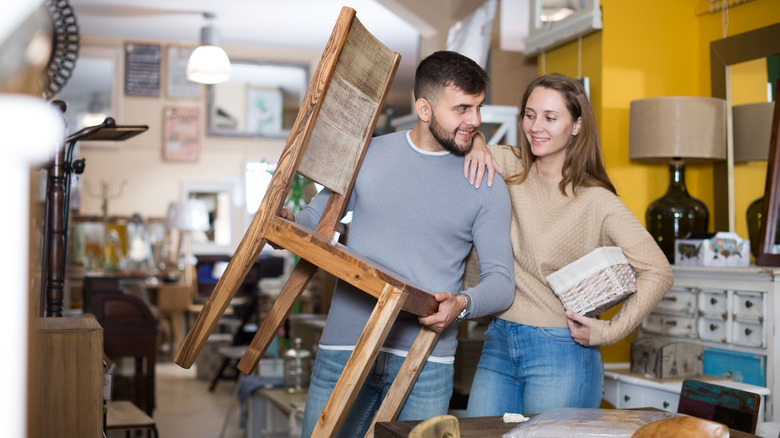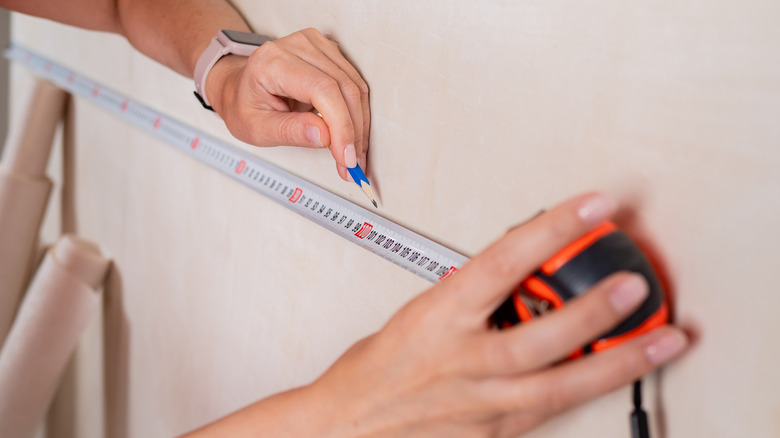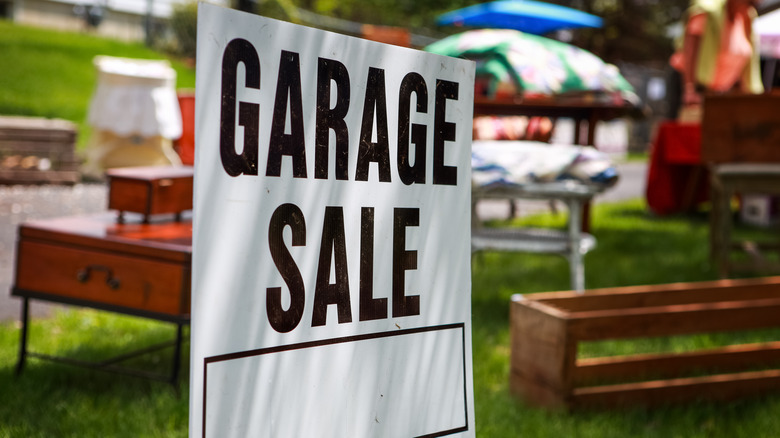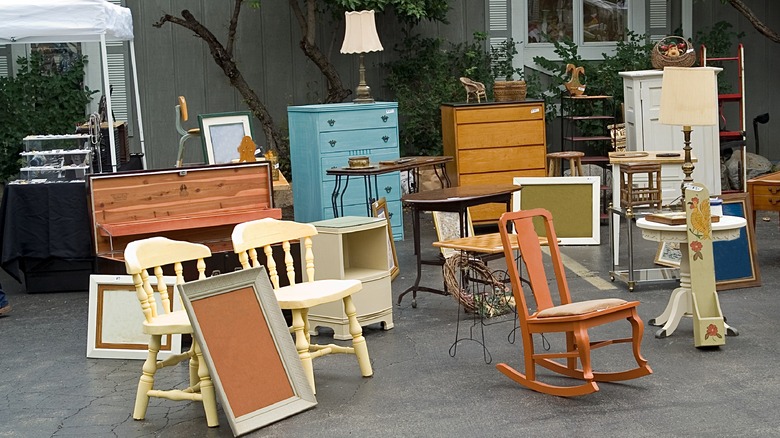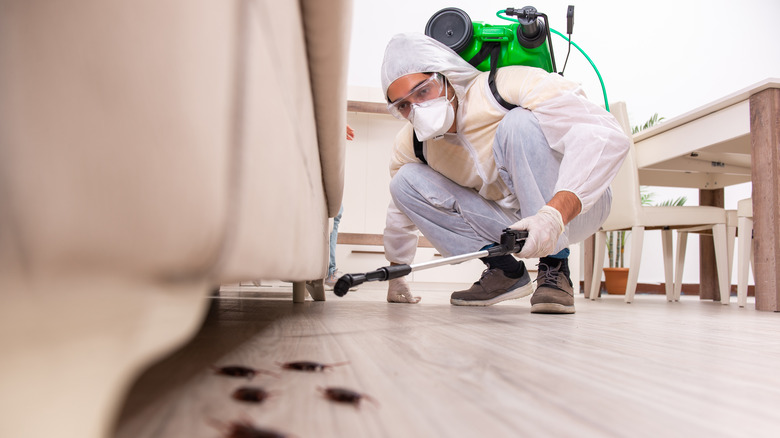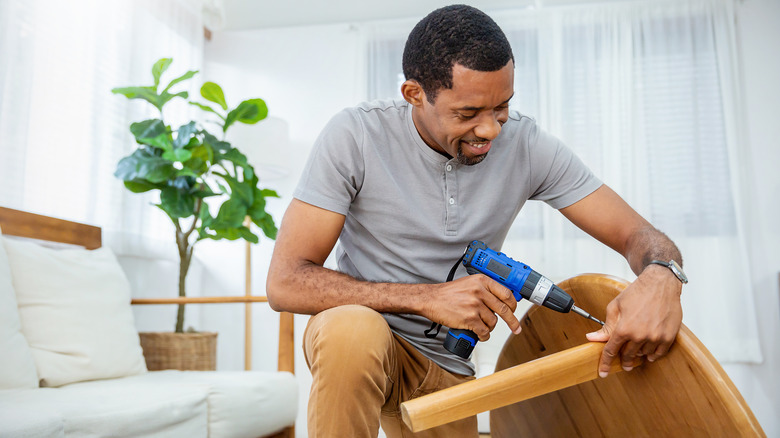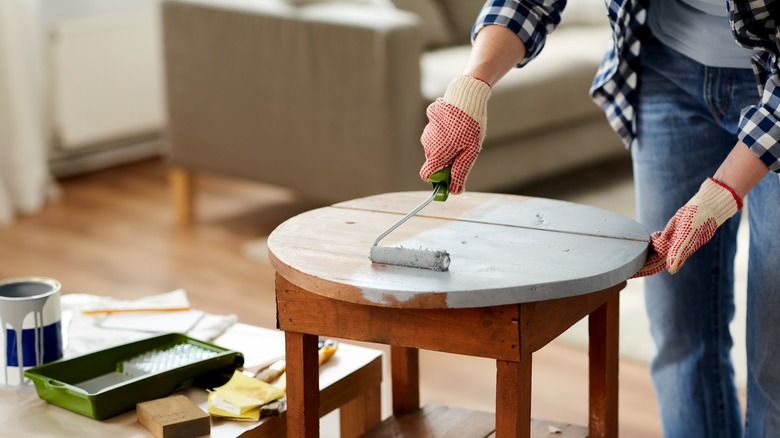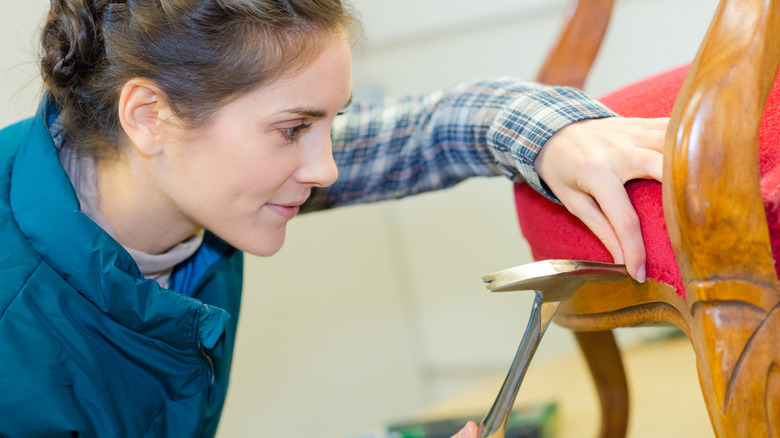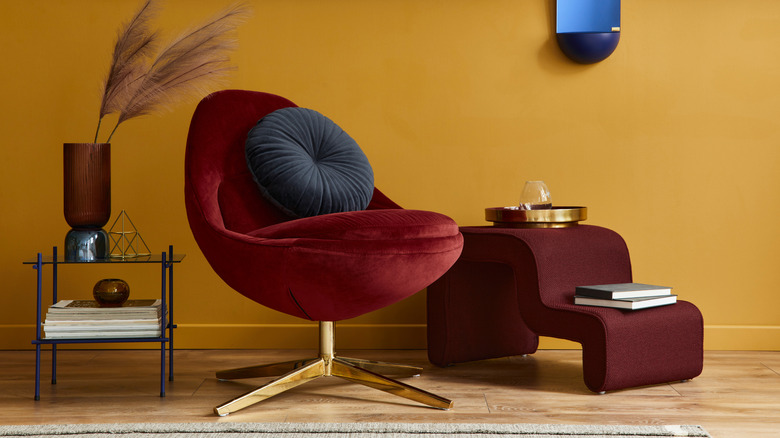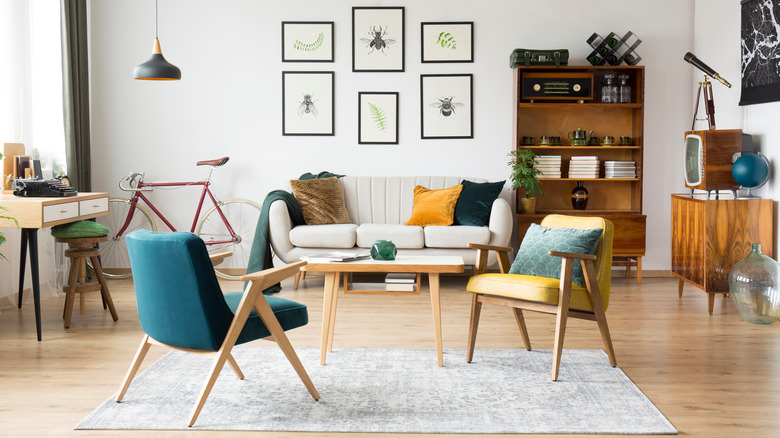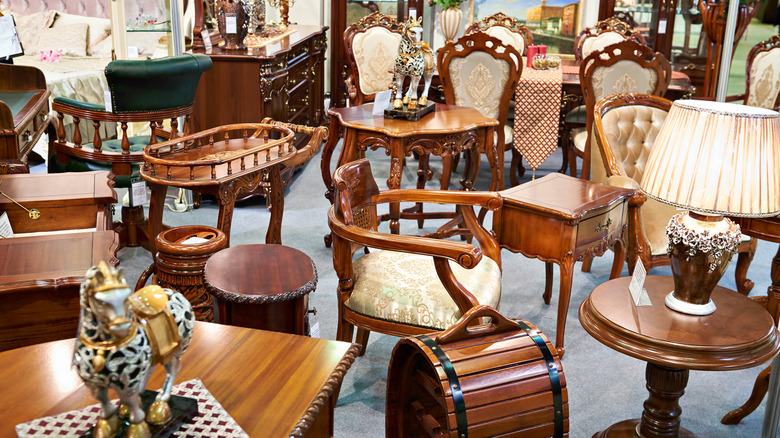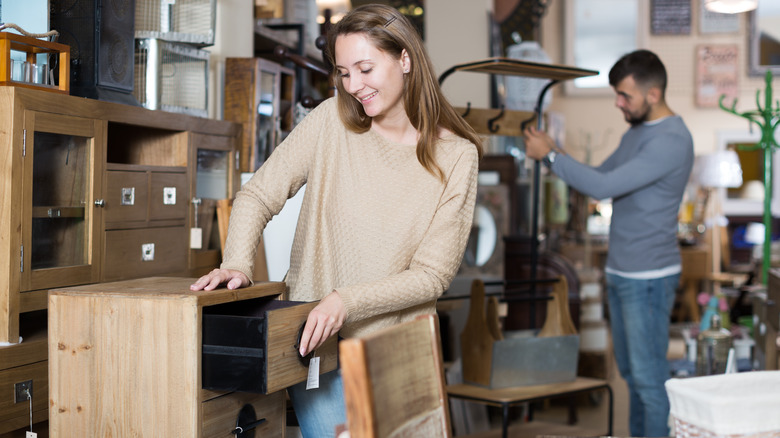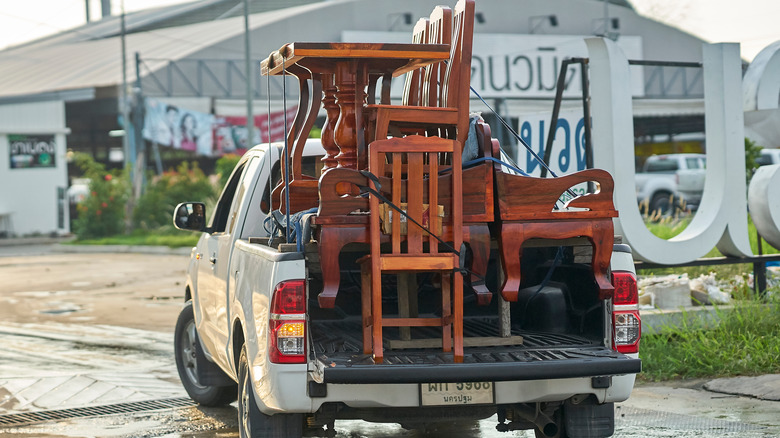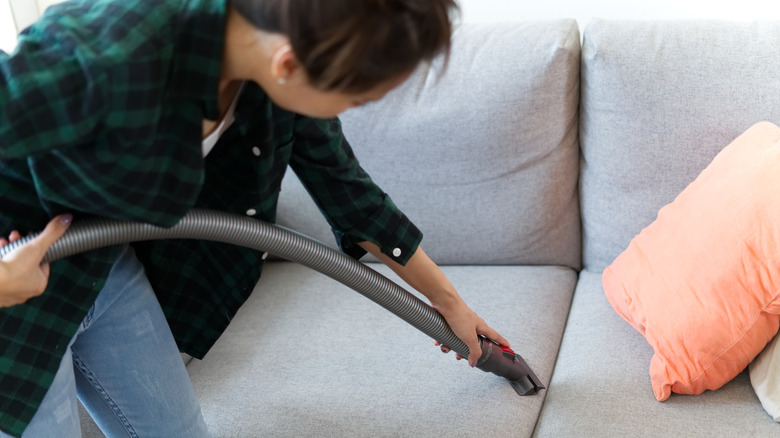21 Smart Tips For Buying Second-Hand Furniture
Whether you're decorating your home on a budget or simply like to shop in eco-friendly ways, you may want to consider buying second-hand furniture when you're in need of a new (to you) living room couch, dining room table, or desk for your home office. Along with hopefully being thrilled with what you find, you might end up enjoying the entire experience. "Once you've dipped your toe in the second-hand pool a few times, you'll be wanting to swim in it forever," Antonia Timpany, the founder of Timpanys (which focuses on preloved items), told Forbes. She then added a message directly to potential second-hand shoppers. "Welcome to guilt-free consumption as you reduce your personal impact on the earth and on your fellow humans," she continued. "[When you find] the perfect item at a price you think 'that must be wrong' ..., it is just fantastically, addictively, fun."
At the same time, if you simply head out and buy the first item that catches your thrifting eye, you might find out that you've made a costly mistake. That's because there are various things that you should definitely do and other things that you absolutely don't want to do while shopping for a piece of pre-used home décor.
1. Know what you need
While you can't always find exactly what you're looking for when you opt to shop for second-hand items, you can still help to narrow down your search by knowing exactly what you need. Make a list of the kind of furniture you require as well as the potential styles, colors, and designs that you're interested in.
2. Measure your space
You don't want to find a second-hand sofa, dresser, or table and bring it home only to find out that it doesn't fit where you intended to put it. Or, even worse, it won't even fit through the door or down your hallway. That's why you need to measure any space before you buy furniture for it.
3. Set a budget
Just because you've opted to buy second-hand furniture doesn't mean that you can necessarily buy anything and everything you see. Not all places sell things for super-cheap prices and you may only have so much to spend. Before you head out shopping, you might want to set a budget that's either firm or a little flexible.
4. Know where to find deals
You may have a few favorite thrift store which you should obviously check out while searching for second-hand furniture. However, don't forget about the various other options. Many people sell the furniture they no longer want at garage sales as well as in online markets. You can also check out estate sales and auctions.
5. Be open-minded
If you don't find what you're looking for but come across a great find at a fabulous price, then you may want to take advantage of the opportunity and pick it up. At the same time, you'll need to ensure that you have a spot for your unexpected purchase unless you're able to store it in the meantime.
6. Look for damage
Due to the fact that pieces of second-hand furniture have already been used, you shouldn't be surprised to find a bit of wear and tear in the form of little rips or scratches. However, you need to keep an eye out for any significant damage that could threaten the functionality, longevity, or worth of the piece.
7. Check for bugs
Unfortunately, second-hand items can sometimes be crawling with nasty bugs. Not only do you not want that in your furniture but you also don't want the critters to get into your home and create an infestation. Keep an eye out for the bugs themselves as well as signs that they've been chewing on the wood or fabric.
8. Smell for stinky issues
While you don't want to put your face too close to potentially soiled second-hand furniture, you need to get close enough to take a sniff. When you do so, you might pick up the scent of anything from cigarette smoke to pet urine that could have permanently ruined the piece and you should obviously avoid it.
9. Consider what you can fix
Just because a piece of furniture is damaged doesn't mean that you have to leave it behind. Instead, consider whether you can fix any issues with a little DIY effort. On the other hand, be sure to be honest with yourself if you don't have the ability, time, or budget to repair it.
10. Buy pieces you can paint
Don't let the fact that a piece of second-hand furniture is an ugly color or a shade that won't match the existing décor in your home deter you if it's ideal in other ways. Some items can be given new life with a fresh coat of paint. You can also sand and re-stain wood.
11. Some things can be reupholstered
In the same way that you shouldn't let a less-than-ideal paint color scare you off, you also don't want to be deterred by second-hand furniture with ugly, outdated, or worn fabric. Sofas and chairs can often be reupholstered to recapture their former style or to give them an entirely new look.
12. Consider unique pieces
One of the benefits of buying second-hand pieces is the fact that you can find items that aren't the same mass-produced options available at every big-box store across the country. Instead, you can come across unique furniture that you won't find anywhere else and that will help to make your home a truly special space.
13. Look for trendy items
While not all second-hand items are modern and contemporary, that doesn't mean that you can't track down furniture that's trendy. For instance, vintage and retro items tend to be popular as are any minimalist, art deco, and art nouveau items — which you might be lucky enough to spot, just to name a few examples.
14. Watch out for valuable antiques
When items are donated to thrift stores, sold at garage sales, or go up for auction, some people don't realize or care that they're getting rid of precious and sometimes valuable antiques. If you appreciate older pieces, then you can watch out for second-hand furniture that's also a timeless treasure.
15. Keep an eye out for labels
If you don't know the aspects that each furniture style features, then you can simply keep an eye out for labels. If you see one on a piece of second-hand furniture — sometimes underneath or on the back — quickly use Google to search for the information on it to see what you might have found.
16. Beware of recalled pieces
Furniture can be recalled for a number of reasons, including production mistakes and various dangers. These items should be discarded in a safe manner and not donated. However, some recalled pieces may still be sold and you'll want to avoid them. To be sure, look up the name of the product and search for recall notices.
17. Look out for missing parts
It can certainly be frustrating to discover that you've purchased something that's missing a part. Beyond that, if it's missing something that's vital to its construction or function, then you might not be able to use your furniture. To make sure that you don't waste your money, ensure that all needed parts are included.
18. Ask before you test
Not every store appreciates when shoppers sit or lay down on items and potentially rip, stain, or break their merchandise. Of course, you also want to be able to test out something before you buy it. In that case, simply seek out an employee and they will surely be able to help you out.
19. Figure out transportation or shipping
Before you buy second-hand furniture — especially something that you can't return — make sure you have a vehicle big enough to take it home or that you'll be able to have it shipped. While big box stores usually offer shipping, not all thrift shops have that service available; the same goes for garage sales.
20. Negotiate the price if appropriate
In some places around the world and at some second-hand markets, you're expected to haggle over the price. However, in other areas and shops, it's considered to be rude and sometimes even offensive to question a listed price. Know what's appropriate for wherever you happen to be and negotiate a better deal if appropriate.
21. Clean your new second-hand furniture
Depending on where you found your new piece of second-hand furniture, it may have been cleaned before it even went up for sale. On the other hand, some pre-used items can be dirty when you bring them home. In that case, give furniture a wash, vacuum, or polish depending on what it needs.
